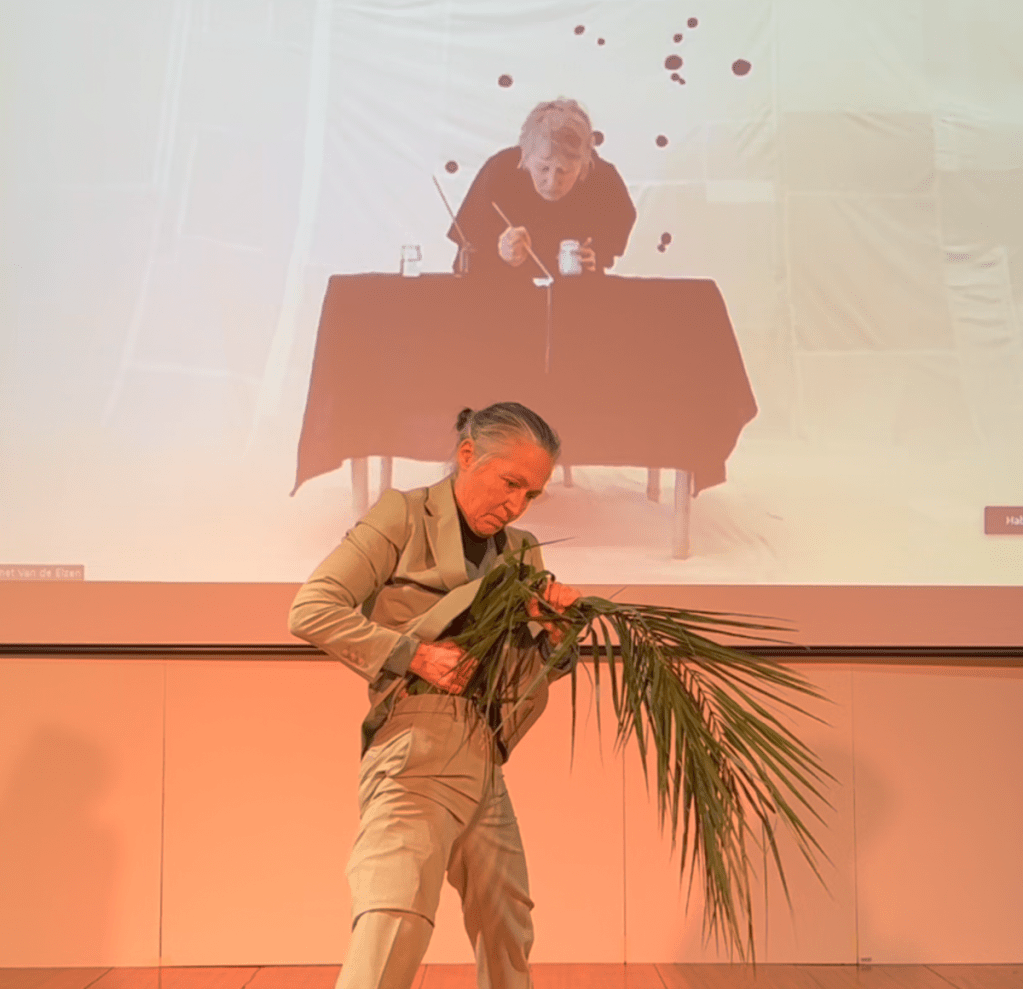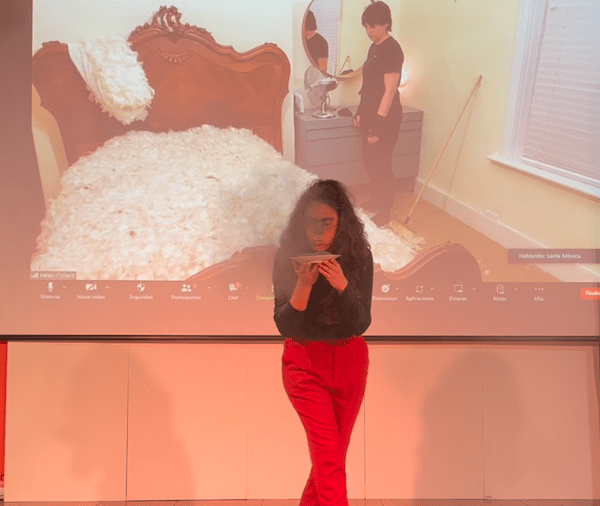Ocells al Cap were invited by the arts centre Santa Monica in Barcelona to curate three evenings of performance in the season of events Dimecres de So I Cos (Sound and Body on Wednesdays). On the first evening (the 24th January 2024), there were two groups of artists. One group were physically present in the arts centre Santa Monica, and the other group were connected to the arts centre by video from different countries. The name of one artist from each group was selected by chance and they both performed simultaneously. For these duets, the artist connected by video was projected onto a wall and the partner artist performed live in front of the projection in such a way that it was possible to watch them both working at the same time in different spaces.
In this work Telepathic Duets, the artists have no previous knowledge of what the others will do. There is a random selection of pairs and these make their performance without watching each other work. The whole performance duet becomes visible to the artist only when they watch the documentation of it.
The artists who performed live were: Denys Blacker, Toni Crabb, Natàlia Espinet, Juliette Murphy, Paloma Orts and Mireia Zantop, The artists who joined by video were: Helen Collard (in England), Holly Slingsby (In England), Deej Fabyc (In Ireland), Bernadette Hopkins (In N Ireland), Barbara Le Béguec Friedman (In France) and Anet van Den Elzen (In Holland)
During the event, we observed the work for synchronicities and connecting threads of meaning. Several volunteers from the audience were invited to write down what they saw. There was a fruitful and inspiring discussion afterwards between the artists and the audience.






There are many ways of sensing, over and above the five senses that we are most used to referring to. These other kinds of sensing do not depend on the physical body. Extra sensory perception is a term that refers to those kinds of perceptions that are not part of our somatosensory system such as scopeasthesia (the sense of being stared at), telepathy (the ability to receive information at a distance), clairvoyance (the ability to see or hear the spirits of the dead) or precognition (the ability to perceive things or events in the future),
In this particular way of working simultaneously that we have developed in the group, it has become evident over time, that there are synchronicities and an overlapping of ideas that cannot be just coincidence. These add to each individual work many layers of meaning that sometimes coincide to such a degree that they suggest to us something is happening that goes beyond our current understanding of time/space. We speculate that our work might be understood as employing an alogical vibrational language that taps into the collective unconscious and that transmits and receives meaningful but coded messages that as yet we we don’t totally understand. By taking a foray into the deeper levels of consciousness we hope to learn more about coherent and intuitive ways of communicating that might free us to connect with a more authentic and spontaneous creative practice. Understanding is not only limited to the mental but the physical and the spiritual. Agency is not an individual responsibility rather it is a collective and inclusive problem that remains to be solved.
“The implication of synchronicity is that there must be some kind of medium or mechanism by which we are connected, a field, that although as yet unidentified by science, might explain how the simultaneous appearance of information across time and space could happen. In his development of the concept of the collective unconscious, Jung describes how some individuals are able access unconscious information and primordial images that cannot have come from their own personal experience and that he called mythical thinking (Jung 2014, p.2948). He postulated that this information has ‘a collective meaning, a meaning which is the common property of mankind’ (Jung 2014, p.4456). The Japanese philosopher Yasuo expands this in his concept of the ‘natural collective unconscious’, in which he suggests that humans also resonate with the activity of animals, plants and physical nature (Nagamoto 2008, p.19).” In the Ancient Chinese world-view, events happen in relation to each other and appear in the same time space for a reason. Hatcher describes this as ‘coordinative thinking’ or ‘associative thinking’ where conceptions are placed in relationship to each other, forming patterns. Therefore, things and events have meaning because they exist in relation to each other, their position dependent on their relation to the whole, acting upon each other by resonance (Hatcher 2009). In imagining how the inner and outer might be connected, the British Biologist Rupert Sheldrake has described morphic fields, a collective and accumulative memory in which self-organising systems inherit a memory from previous similar systems, and in which each individual both draws upon and contributes to the collective memory of the species. Comparatively, the cognitive systems scientist, Christine Hardy, has developed Semantic Fields Theory (SFT) that ‘views the mind as a complex Mind-Body-Psyche system, a lattice comprising numerous dynamical networks, called Semantic Constellations (or SeCos)’ (Hardy 2004). Hardy describes Syg energy, that like Jung’s psychic energy, refers to consciousness that operates in a non-local[1] way, as ‘neither bound by space and time, nor to laws of electromagnetic fields’ (Hardy 2015).
Denys Blacker 2008 “Interconnection, Synchronicity and Consciousness in Improvised Performance Art Practices”
[1] Non-local consciousness understands consciousness as existing separately from the brain and as funneled through or translated by the brain. A large body of evidence from controlled, peer-reviewed research provides support for this non-local model of consciousness and can be consulted at: http://deanradin.com/evidence/evidence.htm Retrieved 20 February 2018.
[2] The collective unconscious according to Jung, was a stratum of universal consciousness shared with all humans, that has been accumulated in an ancestral past and that ‘appears to consist of mythological motifs or primordial images’ (Jung 2014, pt.325).
